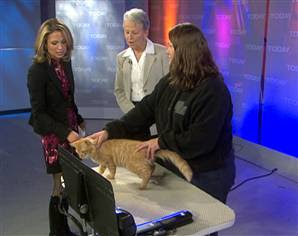By Michael Inbar
Betsy Dresser, senior vice president for the institute, explained to TODAY’s Amy Robach the process of producing a kitty that strangely glows, but is otherwise as normal as any of its brethren. “Two of our scientists at the center worked together with the Louisiana State University Health Sciences Center,” Dresser said. “They introduced a gene that would then produce a protein that glowed fluorescent green.”
While it’s certainly a neat scientific parlor trick, Dresser told TODAY the research that led to the glowing cloned Mr. Green Genes is vitally serious — both to combat animal diseases via gene therapy and, later, to increase the possibility of inserting good genes into humans while taking bad genes out.
But to verify that the gene implants were working, scientists needed to try them out on a cat, because the animals have much of the same genetic makeup as humans. And to see if the genes actually made it into the finished, cloned cat, a gene was inserted that produces a fluorescent protein.
“We wanted to know for sure that we could insert this gene into a cell and have it multiply,” Dresser explained. “If nothing glows, we wouldn’t know if the gene was really inserted. So, because it glows, we know we inserted the gene and were successful with that technique.”
The nose glows
While Mr. Green Genes pawed playfully and rolled on his back for handler Kelly Trimble, Dresser explained that all the cat’s skin cells glow with the green fluorescent protein but, because it’s a furry critter, only the eyes, ears and nose display wattage under ultraviolet. “If we were to shave him, he would glow totally,” Dresser told Robach.
Dresser was also quick to note there is nothing cruel and unusual involved in producing a cat that glows in the dark. “It’s totally harmless,” Dresser said. “He’s just a normal cat; he doesn’t know he’s glowing.”
As host Amy Robach looks on, Mr. Green Genes’ handlers prepare to expose the cat to an ultraviolet lamp.
Normal or not, Mr. Green Genes might one day be considered a pioneer and hero in the advancement of genetics. For example, in endangered animal species that carry a gene making them prone to a specific disease, that gene could be pulled out at the embryo stage to give the species a better chance at surviving and prospering.
For mankind, it might lead to new innovations in treating diabetes, Dresser said. “In a diabetic human, there are genes that make insulin. If we can insert genes that make diabetics produce their own insulin, then we hope to stop diabetes.
“It’s helpful to both animals and humans,” she added.
But that’s the future. In the present, Mr. Green Genes can look forward to a normal life — unless he’s exposed to a black light, the secret of his glow is safe.
And Mr. Green Genes’ offspring might have a bright future too, Dresser said. “We’ll breed him and we’ll see if his kids glow, too!”
Wouldn't this be great for our hairy friends on our camping trips. No chance of him getting lost in the dark! What a novel idea!















No comments:
Post a Comment